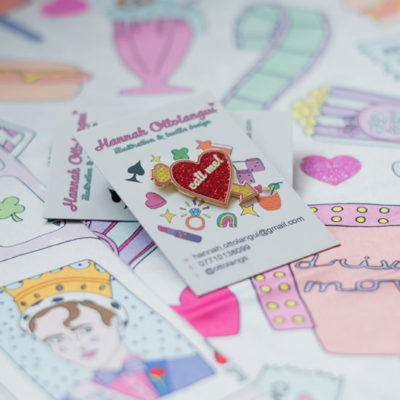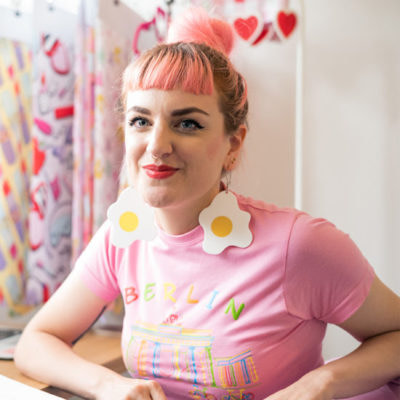“Always remember – you started your business because you love what you do”

Textile designer Hannah has only just launched her design career but she’s already rocking it! Find out how she’s got her style started – and where she gets her inspiration from.
Hannah Ottolangui is a freelance textile designer and illustrator from Leeds. Her bright, bold, beautiful designs mix everyday objects with a touch of humour. The result? Fabrics that make you instantly happy! She recently graduated from the Leeds College of Art as a mature student, and now she’s in the process of starting her own fashion and jewellery brand – and she’s rocking it! Find out how she’s been building her freelance career, her tips for setting up a craft event stand and why Business Cards are a crucial part of her branding.
How did you get into illustration?
I’ve always done creative courses – I actually started a Fine Art degree but it was a little too broad and conceptual for me. I knew I wanted to do more print based work so I took some time out from studying, and researched printed textile courses – I felt this would suit me better and allow me to do everything I wanted.
I’ve drawn for as long as I can remember, and I’ve always been interested in how illustration translates to print, so the course I took at LCA was perfect for me!
You have a fabulous and instantly recognisable style – what are your influences?
Other cultures have always been a huge inspiration for me, particularly Japanese youth culture. Japanese street style is the best thing ever – it completely struck a chord with me! I always felt like I didn’t really fit in anywhere, but when I saw this stuff, I thought wow, this is my dream. So, I went to Tokyo last Summer – I wanted to absorb the rich coloured surroundings and take in all the context.
Pop culture in general is a huge influence too. I take a lot of inspiration for my colour palettes from films – my current collection is Americana themed. I looked for films set in Vegas to get that kitsch American colour palette and shows such as True Romance gave me a lot of inspiration for this collection too.
Since starting university how have you seen your illustration style develop?
I always knew what I was interested in and what my style was – that hasn’t changed – I’ve just improved at generating ideas.
When I started university, I couldn’t use Photoshop – I taught myself over time and it’s changed my process tremendously. Trying to screen print all of my different motifs and designs would be awful. Photoshop gives me the ability to print my designs whilst refining the colour so that it’s exactly how I want it to be.
Some of your prints have now been made into garments and are being sold on ModCloth. How did this partnership come about?
During my second year at uni, we got taken to Première Vision in Paris – a huge fashion trade show. We all designed a collection to be sold specifically at the event. I went on to sell two prints to a company called Alexander Henry Fabrics – they produce lots of different illustrative prints and then sell those fabrics on to other companies. ModCloth bought the fabric from Alexander Henry and later went on to make garments with it.
I didn’t know ModCloth had created garments with my fabric until someone messaged me on Instagram asking if the print was mine. It was amazing, but a little weird as nobody really knows that it’s actually my print. One of the reasons I want to work freelance is so that I can get my name out there on my work.
What have you been doing to build your freelance career since graduating?
At the moment I’m in the process of contacting people to collaborate. I also exhibited at New Designers – a design fair in London – it was great for networking and getting my work in front of the right people.
Do you have any tips for setting up a successful stall at craft fairs and events?
That’s a tough one – apart from exhibiting at New Designers – the International Women’s Day craft fair was my first one. I think my main tip would be to make sure that your stand really reflects your aesthetic. I decided to print my designs onto tote bags and made perspex jewellery as well as having some prints on display. I laid everything out and pinned a few bits up – I didn’t want to invest too much in my first stand as I wasn’t sure how it was going to go down but I went on to sell loads of stuff which was great!
Craft fairs are a great way to get your work out there and hear first hand feedback on your products. Having Business Cards on my stand was a huge help as they acted as miniature prints of my work. People who weren’t buying were still taking a card which led to new followers on Instagram. People don’t always want to buy things immediately, so give them the ability to remember you.
You mentioned you’d created Business Cards – why do you think it’s important for small business to brand themselves?
Your branding needs to show new and existing clients exactly who you are – it’s especially important for a Business Card as it’s often the first thing people see. It needs to stand out and say what you’re about otherwise how are you different from everyone else? Having a different design on every card allows me to have a mini portfolio in my pocket.
You have a beautifully curated Instagram account and sell your products on Etsy – is there anything else you do to promote yourself and your brand?
I want to attend as many craft fairs as I can to get myself out there. I feel that people are more likely to buy your products if they can see them as tangible, quality objects. Other than that, I focus my attention on Instagram because of how visual the platform is. As cringey as we might think hashtags are, they’re such a powerful tool to get your work in front of the right demographic. It’s important to have followers who actually engage though, so don’t overdo it.
What do you think are the biggest challenges for small businesses today?
Standing out from the crowd is definitely the biggest challenge because it’s such an over-saturated industry. It’s also difficult, especially in my field, to figure out whether you want to get your work out there by selling designs to companies without your name being attached to it, or going at it alone. Once the rights have been sold you can’t use those drawings again. Social media can also be challenging – while platforms like Instagram are amazing for promoting yourself, your work can get lost as well.
What are your tips for anyone else wanting to start their own business?
Self-confidence and perseverance are key. Don’t put too much pressure on yourself and feel confident about your ideas. You’ll always be critical of yourself and there’ll be knock backs but just work through them – and stay true to yourself. There’ll always be people who don’t like your work, but then there’ll always be people who do. And, always remember that you started your business because you love what you do.
Brand yourself with Business Cards
Keep in touch
Get design inspiration, business tips and special offers straight to your inbox with our MOOsletter, out every two weeks.



















